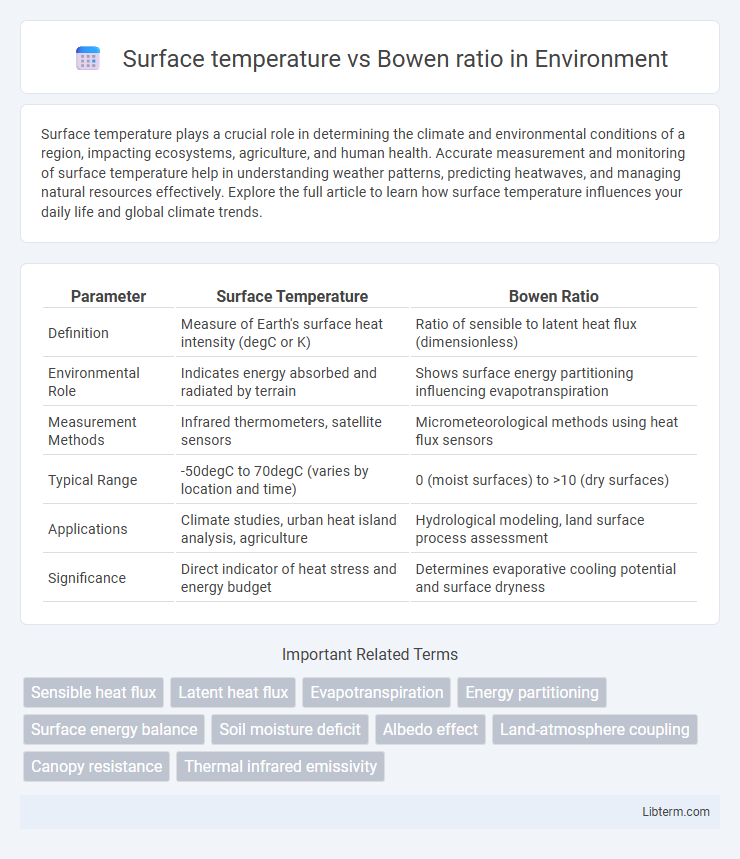Surface temperature plays a crucial role in determining the climate and environmental conditions of a region, impacting ecosystems, agriculture, and human health. Accurate measurement and monitoring of surface temperature help in understanding weather patterns, predicting heatwaves, and managing natural resources effectively. Explore the full article to learn how surface temperature influences your daily life and global climate trends.
Table of Comparison
| Parameter | Surface Temperature | Bowen Ratio |
|---|---|---|
| Definition | Measure of Earth's surface heat intensity (degC or K) | Ratio of sensible to latent heat flux (dimensionless) |
| Environmental Role | Indicates energy absorbed and radiated by terrain | Shows surface energy partitioning influencing evapotranspiration |
| Measurement Methods | Infrared thermometers, satellite sensors | Micrometeorological methods using heat flux sensors |
| Typical Range | -50degC to 70degC (varies by location and time) | 0 (moist surfaces) to >10 (dry surfaces) |
| Applications | Climate studies, urban heat island analysis, agriculture | Hydrological modeling, land surface process assessment |
| Significance | Direct indicator of heat stress and energy budget | Determines evaporative cooling potential and surface dryness |
Introduction to Surface Temperature and Bowen Ratio
Surface temperature represents the energy state of the Earth's surface, measured by sensors detecting emitted infrared radiation, influencing local weather patterns and climate dynamics. The Bowen ratio quantifies the balance between sensible heat flux and latent heat flux at the surface, providing critical insight into land-atmosphere energy exchanges. Understanding the relationship between surface temperature and the Bowen ratio aids in evaluating evapotranspiration rates and surface energy partitioning.
Defining Surface Temperature
Surface temperature refers to the temperature of the Earth's surface, which directly impacts the Bowen ratio by determining the energy partition between sensible and latent heat fluxes. It is measured using radiometric sensors or satellite remote sensing, providing crucial data for understanding surface energy balance. Variations in surface temperature influence evaporation rates and thus modify the Bowen ratio, which is defined as the ratio of sensible heat flux to latent heat flux.
Understanding the Bowen Ratio
The Bowen ratio is a critical parameter in understanding surface temperature dynamics as it quantifies the ratio of sensible heat flux to latent heat flux from the Earth's surface. Surface temperature variations directly influence the Bowen ratio by altering the partitioning of energy between heating the air and evaporating moisture, which impacts local climate and hydrological cycles. Accurate measurement of the Bowen ratio aids in modeling land-atmosphere interactions and predicting responses to environmental changes.
Factors Influencing Surface Temperature
Surface temperature is significantly influenced by the Bowen ratio, which represents the ratio of sensible heat flux to latent heat flux at the Earth's surface. High Bowen ratios typically indicate dry conditions where more energy is allocated to sensible heat, causing elevated surface temperatures, whereas low Bowen ratios reflect moist environments with greater latent heat flux, leading to cooler surface temperatures. Key factors affecting this balance include soil moisture availability, vegetation cover, and solar radiation intensity.
Factors Affecting the Bowen Ratio
The Bowen ratio, representing the ratio of sensible heat flux to latent heat flux, is primarily influenced by surface temperature, soil moisture content, vegetation type, and atmospheric conditions. Higher surface temperatures often increase sensible heat flux, raising the Bowen ratio, especially in arid or sparsely vegetated areas where latent heat flux is limited. Soil moisture availability plays a critical role by enhancing evapotranspiration, thus decreasing the Bowen ratio and impacting local energy balance and microclimate dynamics.
Relationship Between Surface Temperature and Bowen Ratio
The relationship between surface temperature and Bowen ratio is characterized by the partitioning of available energy into sensible and latent heat fluxes, where a higher Bowen ratio indicates more energy allocated to sensible heat, leading to an increase in surface temperature. Surfaces with low moisture availability exhibit elevated Bowen ratios, resulting in higher surface temperatures due to reduced evaporative cooling. Quantitative studies highlight that arid regions typically present Bowen ratios exceeding 1, correlating strongly with increased land surface temperatures compared to humid regions with Bowen ratios below 1.
Measuring Techniques for Surface Temperature
Surface temperature measurement techniques include infrared thermometry, satellite remote sensing, and ground-based radiometers, each offering precise data critical for calculating the Bowen ratio. Infrared thermometers capture emitted thermal radiation, enabling non-contact temperature assessments that enhance temporal resolution in surface energy balance studies. Satellite platforms such as MODIS provide large-scale thermal imagery, allowing integration with Bowen ratio calculations to assess land-atmosphere energy exchanges effectively.
Calculating and Interpreting the Bowen Ratio
The Bowen ratio is calculated by dividing the sensible heat flux by the latent heat flux, providing a critical measure of the partitioning of available energy at the Earth's surface. Surface temperature directly influences this ratio by affecting the rates of sensible and latent heat exchanges; higher surface temperatures generally increase sensible heat flux, leading to a higher Bowen ratio. Accurate interpretation of the Bowen ratio reveals valuable insights into surface energy balance, water stress, and evapotranspiration dynamics essential for climate modeling and agricultural management.
Applications in Climate and Environmental Studies
Surface temperature significantly influences the Bowen ratio by affecting the partitioning of available energy into sensible and latent heat fluxes, which is crucial for understanding land-atmosphere interactions. Accurate measurements of the Bowen ratio help quantify evapotranspiration rates, aiding climate models in predicting regional water cycles and drought occurrences. This relationship is vital for assessing ecosystem responses to climate change and managing agricultural water resources efficiently.
Key Differences and Impacts on Energy Balance
Surface temperature strongly influences the Bowen ratio by dictating the partitioning of available energy into sensible and latent heat fluxes. Higher surface temperatures typically increase sensible heat flux, raising the Bowen ratio, while lower temperatures favor latent heat flux, reducing the ratio. These variations critically impact the surface energy balance, affecting processes such as evapotranspiration, boundary layer development, and regional climate dynamics.
Surface temperature Infographic

 libterm.com
libterm.com